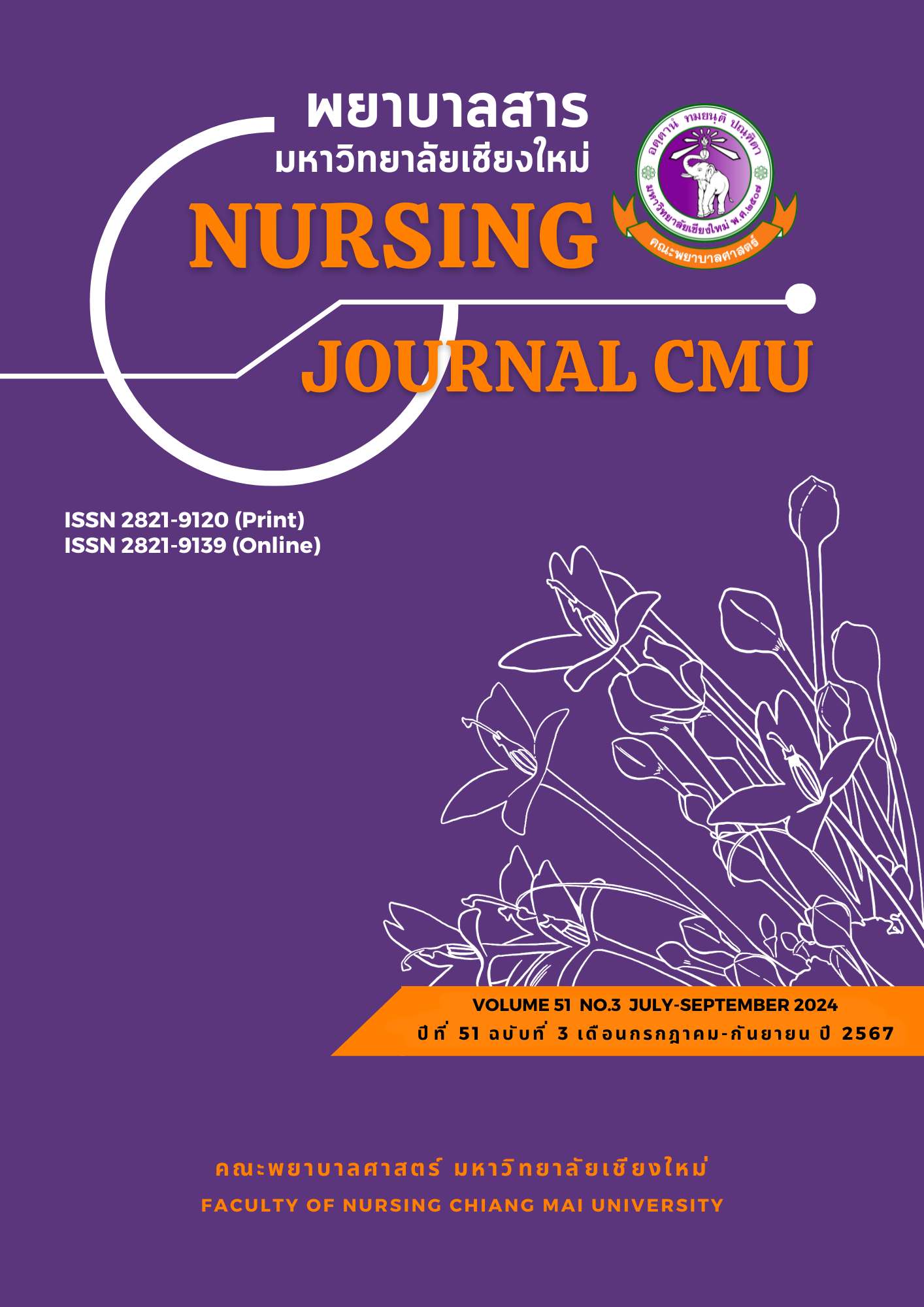ปัจจัยที่สัมพันธ์กับคุณภาพชีวิตด้านสุขภาพในผู้ป่วยโรคหลอดเลือดสมองที่มีอายุน้อย
คำสำคัญ:
คุณภาพชีวิตด้านสุขภาพ, โรคหลอดเลือดสมองอายุน้อย, ปัจจัยที่มีความสัมพันธ์บทคัดย่อ
การเกิดโรคหลอดเลือดสมองในวัยผู้ใหญ่ที่อายุน้อยกำลังเพิ่มขึ้นทั่วโลก ส่งผลให้อัตราการเสียชีวิต การเจ็บป่วย และมีความเสี่ยงในการเกิดซ้ำมากขึ้น การวิจัยเชิงบรรยายครั้งนี้ มีวัตถุประสงค์เพื่อศึกษาคุณภาพชีวิตด้านสุขภาพของผู้ป่วยโรคหลอดเลือดสมองที่มีอายุน้อย และความสัมพันธ์ระหว่างดัชนีมวลกาย ระดับความรุนแรงของโรค อาการเหนื่อยล้า ภาวะซึมเศร้า และความทุพพลภาพทางร่างกายกับคุณภาพชีวิตด้านสุขภาพ โดยสุ่มเลือกโรงพยาบาลขนาดตติยภูมิในเขตกรุงเทพมหานคร จำนวน 3 โรงพยาบาล กลุ่มตัวอย่างจำนวน 150 คน คัดเลือกตามคุณสมบัติที่กำหนดไว้ เครื่องมือวิจัยประกอบด้วยแบบสอบถามข้อมูลส่วนบุคคล แบบประเมินระดับความรุนแรงของโรคหลอดเลือดสมอง แบบประเมินความเหนื่อยล้า แบบประเมินอาการซึมเศร้า แบบประเมินระดับทุพพลภาพทางร่างกาย และแบบประเมินคุณภาพชีวิตด้านสุขภาพของผู้ป่วยโรคหลอดเลือดสมอง มีค่าดัชนีความตรงเชิงเนื้อหาได้เท่ากับ .93-1.00 ค่าความเชื่อมั่น คำนวณโดยหาค่า Cronbach’s alpha ได้ค่าเท่ากับ .84-.98 และค่าความเชื่อมั่นระหว่างผู้ประเมิน ค่า kappa เท่ากับ .82 และค่า weighted kappa เท่ากับ .90 วิเคราะห์ข้อมูลโดยใช้สถิติ Pearson’s product moment correction, Spearman’s rank correlation และ Point biserial correlation
ผลการวิจัยพบว่า ผู้ป่วยโรคหลอดเลือดสมองอายุน้อยมีคุณภาพชีวิตด้านสุขภาพโดยรวมอยู่ในเกณฑ์ดี มีคะแนนเฉลี่ยเท่ากับ 210.96 (SD = 32.85) และพบว่า ระดับความรุนแรงของโรค ภาวะซึมเศร้า อาการเหนื่อยล้า ความทุพพลภาพทางร่างกาย และดัชนีมวลกาย มีความสัมพันธ์ด้านลบกับคุณภาพชีวิตด้านสุขภาพในผู้ป่วยโรคหลอดเลือดสมองอายุน้อยอย่างมีนัยสำคัญทางสถิติที่ .05 (r = -.77, -.71, -.66, -.60 และ -.56 ตามลำดับ)
ผลการศึกษาครั้งนี้ สามารถนำไปเป็นข้อมูลพื้นฐานสำหรับบุคลากรทางสุขภาพในการส่งเสริมคุณภาพชีวิตด้านสุขภาพในผู้ป่วยโรคหลอดเลือดสมองอายุน้อย
References
Alotaibi, S. M., Alotaibi, H. M., Alolyani, A. M., Abu Dali, F. A., Alshammari, A. K., Alhwiesh, A. A., Gari, D. M., Khuda, I. K. M. Q., & Vallabadoss, C. A. (2021). Assessment of the stroke-specific quality-of-life scale in KFHU, Khobar: A prospective cross-sectional study. Neurosciences, 26(2), 171-178. https://doi.org/10.17712/nsj.2021.2.20200126
Boot, E., Ekker, M. S., Putaala, J., Kittner, S., De Leeuw, F. E., & Tuladhar, A. M. (2020). Ischaemic stroke in young adults: A global perspective. Journal of Neurology, Neurosurgery and Psychiatry, 91(4), 411-417. https://doi.org/10.1136/jnnp-2019-322424
Buapang, S., & Phutthikhamin, N. (2016). Quality of life of stroke in the young at the out-patient department of Srinagarind Hospital. North-Eastern Thai Journal of Neuroscience, 11(4), 61-75. (in Thai)
Chen, C. M., Tsai, C. C., Chung, C. Y., Chen, C. L., Wu, K. P., & Chen, H. C. (2015). Potential predictors for health-related quality of life in stroke patients undergoing inpatient rehabilitation. Health and Quality of Life Outcomes, 13, 118. https://doi.org/10.1186/s12955-015-0314-5
Chiangchaisakulthai, K., Suppradist, W., & Samphak, N. (2019). Final report on the evaluation of intermediate care service. International Health Policy Program, Thai Health Promotion Foundation. (in Thai)
Deb-Chatterji, M., Pinho, J., Flottmann, F., Meyer, L., Broocks, G., Brekenfeld, C., Reich, A., Fiehler, J., Gerloff, C., Thomalla, G., & GSR-ET Investigators. (2021). Health-related quality of life after thrombectomy in young-onset versus older stroke patients: A multicenter analysis. Journal of NeuroInterventional Surgery, 14(11), 1145-1150. https://doi.org/10.1136/neurintsurg-2021-017991
Dromerick, A. W., Edwards, D. F., & Diringer, M. N. (2003). Sensitivity to changes in disability after stroke: A comparison of four scales useful in clinical trials. Journal of Rehabilitation Research & Development, 40(1), 1-8. https://doi.org/10.1682/jrrd.2003.01.0001
European Stroke Organisation. (2018). ESOC 2018 - Stroke in the young. https://eso-stroke.org/esoc-2018-stroke-in-the-young/
Ferrans, C. E., Zerwic, J. J., Wilbur, J. E., & Larson, J. L. (2005). Conceptual model of health-related quality of life. Journal of Nursing Scholarship, 37(4), 336-342. https://doi.org/10.1111/j.1547-5069.2005.00058.x
Ignacio, K. H. D., Diestro, J. D. B., Medrano, J. M. M., Salabi, S. K. U., Logronio, A. J., Factor, S. J. V., Ignacio, S. D., Pascual V, J. L. R., & Pineda-Franks, M. C. C. (2022). Depression and anxiety after stroke in young adult Filipinos. Journal of Stroke and Cerebrovascular Diseases, 31(2), 106232. https://doi.org/10.1016/j.jstrokecerebrovasdis.2021.106232
Krupp, L. B., LaRocca, N. G., Muir-Nash, J., & Steinberg, A. D. (1989). The fatigue severity scale. Application to patients with multiple sclerosis and systemic lupus erythematosus. Archives of Neurology, 46(10), 1121-1123. https://doi.org/10.1001/archneur.1989.00520460115022
Kuptniratsaikul, V., & Ketumarn, P. (1997). The study of the Center for Epidemiologic Studies-Depression Scale (CES-D) in Thai people. Siriraj Hospital Gazette, 49(5), 442-448. (in Thai)
Munro, B. S. (2001). Statistical Methods for Healthcare Research (4th ed.). Lippincott.
Naess, H., Waje-Andreassen, U., Thomassen, L., Nyland, H., & Myhr, K. M. (2006). Health-related quality of life among young adults with ischemic stroke on long-term follow-up. Stroke, 37(5), 1232-1236. https://doi.org/10.1161/01.STR.0000217652.42273.02
National Institute for Emergency Medicine. (2022). Situations and trends in health and emergency medicine (World class and Thailand). https://www.niems.go.th/1/UploadAttachFile/2022/EBook/414764_20220208161448.pdf
National Institute of Neurological Disorders and Stroke. (2019). Stroke scales and related information. National Institute of Neurological Disorders and Stroke.
Nilanont, Y., Phattharayuttawat, S., Chiewit, P., Chotikanuchit, S., Limsriwilai, J., Chalernpong, L., Yamkaew, N., Lirathpong, N., Anprasertporn, P., Komoltri, C., Prayoonwiwat, N., & Poungvarin, N. (2010). Establishment of the Thai version of National Institute of Health Stroke Scale (NIHSS) and a validation study. Journal of the Medical Association of Thailand, 93(Suppl 1), S171-S178. https://www.ncbi.nlm.nih.gov/pubmed/20364572 (in Thai)
Phiwkhao, S., Jitpanya, C., & Preechawong, S. (2017). Relationships among coping, social support, perceived self-efficacy and health related-quality of life in first-time stroke patients. HCU Journal of Health Science, 21(41), 123-136. (in Thai)
Radloff, L. S. (1977). The CES-D scale: A self-report depression scale for research in the general population. Applied Psychological Measurement, 1(3), 385-401. https://doi.org/10.1177/014662167700100306
Sawasdee, A., Preechawoong, S., & Jitpanya, C. (2017). Relationships between pain, sleep quality, depressive symptoms, and fatigue in post stroke patients. Kuakarun Journal Nursing, 24(2), 7-22. (in Thai)
Tsalta-Mladenov, M., & Andonova, S. (2021). Health-related quality of life after ischemic stroke: Impact of sociodemographic and clinical factors. Neurological Research, 43(7), 553-561. https://doi.org/10.1080/01616412.2021.1893563
Uyttenboogaart, M., Stewart, R. E., Vroomen, P. C. A. J., De Keyser, J., & Luijckx, G. J. (2005). Optimizing cutoff scores for the Barthel index and the modified Rankin scale for defining outcome in acute stroke trials. Stroke, 36(9), 1984–1987. https://doi.org/10.1161/01.STR.0000177872.87960.61
Williams, L. S., Weinberger, M., Harris, L. E., Clark, D. O., & Biller, J. (1999). Development of a stroke-specific quality of life scale. Stroke, 30(7), 1362-1369. https://doi.org/10.1161/01.str.30.7.1362
Wong, H. J., Lua, P. L., Harith, S., & Ibrahim, K. A. (2021). Health-related quality of life profiles and their dimension-specific associated factors among Malaysian stroke survivors: A cross sectional study. Health and Quality of Life Outcomes, 19(1), 210. https://doi.org/10.1186/s12955-021-01847-0
World Health Organization. (2022). World Stroke Day 2022. https://www.who.int/srilanka/news/detail/29-10-2022-world-stroke-day-2022
Yoon, S., Kim, H. Y., & Kim, S. R. (2021). A prediction model of health-related quality of life in young adult patients with stroke. Journal of Clinical Nursing, 30(13-14), 2023-2035. https://doi.org/10.1111/jocn.15755D
Downloads
เผยแพร่แล้ว
How to Cite
ฉบับ
บท
License
Copyright (c) 2024 พยาบาลสาร มหาวิทยาลัยเชียงใหม่

This work is licensed under a Creative Commons Attribution-NonCommercial-NoDerivatives 4.0 International License.
บทความที่ได้รับการตีพิมพ์เป็นลิขสิทธิ์ของวารสารพยาบาลสาร
ข้อความที่ปรากฏในบทความแต่ละเรื่องในวารสารวิชาการเล่มนี้เป็นความคิดเห็นส่วนตัวของผู้เขียนแต่ละท่านไม่เกี่ยวข้องกับมหาวิทยาลัยเชียงใหม่ และคณาจารย์ท่านอื่นๆในมหาวิทยาลัยฯ แต่อย่างใด ความรับผิดชอบองค์ประกอบทั้งหมดของบทความแต่ละเรื่องเป็นของผู้เขียนแต่ละท่าน หากมีความผิดพลาดใด ๆ ผู้เขียนแต่ละท่านจะรับผิดชอบบทความของตนเองแต่ผู้เดียว





